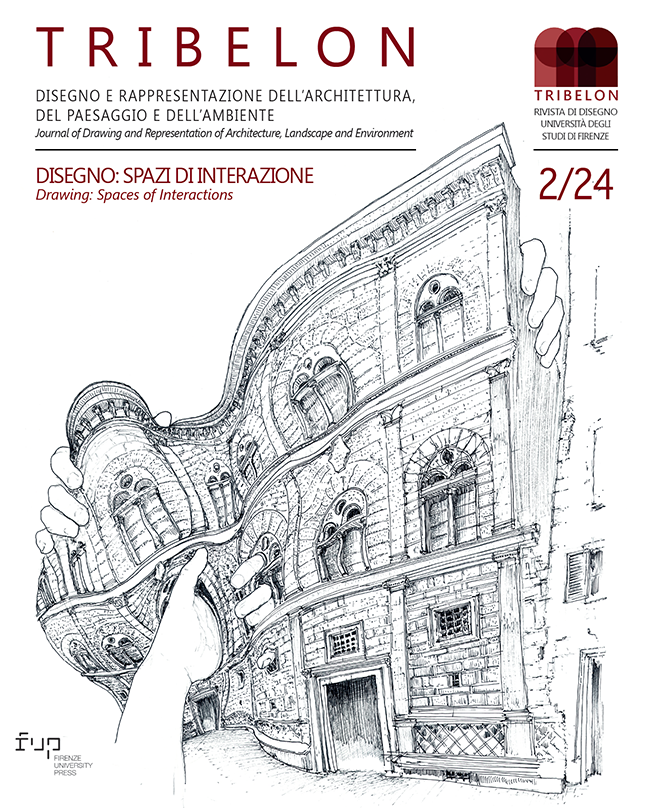Published 2024-12-19
Keywords
- Duilio Cambellotti,
- Greek Theatre of Syracuse,
- stage movement,
- costumes,
- stage direction
How to Cite
Copyright (c) 2024 Santi Centineo

This work is licensed under a Creative Commons Attribution 4.0 International License.
Abstract
The role of the theatre director is a recently established figure. In fact, since the time of the Greek tragedians, it is mostly the author himself who gives the actors gestural indications, while a real geography of almost recurrent and stylized movements is most often noted laterally or incidentally in the text.At the beginning of the twentieth century, the extension of the visual imagery and the taking charge of the historical repertoire require the care of a more complex directorial institution, especially when the author is no longer present to give indications, nor his annotations in the margins of the text are any longer sufficient to define a movement that is no more just convention.
When the Roman artist Duilio Cambellotti (1876-1960), designs the scenes for the first editions of the Ancient Drama Season at the Teatro di Siracusa, from 1914 until 1948, the role of the director is not yet institutionalized, al-though it was recognizable the need for a stylistic and technical guide to the movements of actors. So, many times the scenic sketch, almost as a necessity, prefigures the move-ments of the director, not only from the technical point of view of a simple "geography" of stage, but above all from the stylistic point of view, in a visual and gestural unity.
Through the examination of some sketches by Duilio Cambellotti, the paper highlights how this practice is symptomatic of the prevalence of the interpretive aspect over that textual and how the visual project of the show is no longer the result of a single worker (generally anchored to the pictorial magisterium), but rather the result of a multiple synergy between three-dimensional and four-dimensional apparatuses
References
- AA. VV., Ombre della parola. Ottanta anni di teatro antico nella Siracusa del Novecento 1914-1994, catalogo della mostra tenutasi a Siracusa, Palazzo Gargallo al Carmine dal 15 maggio al 30 giugno 1994, Arnaldo Lombardi Editore, Palermo 1994.
- M. Centanni, Artista di Dioniso. Duilio Cambellotti e il Teatro greco di Siracusa, 1914-1948, Electa, Milano 2004.
- M. Centanni, Duilio Cambellotti a Siracusa, 1914-1948. Poetica e pratica teatrale, LetteraVentidue, Siracusa 2021.
- S. Centineo, Representamen. Architettura degli interni, musica, società, Kalós, Palermo, 2020.
- S. Centineo, Prime mappature fisiologiche nell’epoca della riproducibilità tecnica: Eadweard Muybridge, Étienne-Jules Marey e la cattura del movimento, in E. Cicalò, V. Menchetelli, M. Valentino (a cura di), I linguaggi grafici - Mappe, Publica, Alghero 2022, pp. 1188-1215.
- S. Centineo, Città di carta, città in fiamme. La rappresentazione dell’assedio nella scenografia teatrale, in R. Amore, M. I. Pascariello, A. Veropalumbo (a cura di), Città e guerra. Difese, distruzioni, permanenze delle memorie e dell’immagine urbana, Atti del X Convegno Internazionale di studi CIRICE, Napoli, 8-10 giugno 2023. Federico II University Press, Collana Storia e iconografia dell’architettura, delle città e dei siti europei, 8/II, Napoli 2023, pp. 263-270.
- V. Crespi Morbio, (a cura di), La Scala e l’Oriente 1778-2004, Electa, Milano 2004.
- V. Crespi Morbio, Alessandro Sanquirico. Teatro, feste, trionfi, 1777-1849, Amici della Scala, Milano 2013.
- V. Di Benedetto, E. Medda, La tragedia sulla scena, Einaudi, Torino 1997.
- O. Di Tondo, F. Pappacena, A. Pontremoli, Storia della Danza e del Balletto, Gremese, Roma 2019.
- U. Eco, Semiologia e filosofia del linguaggio, Einaudi, Torino 1984.
- R. M. Fabris, «Il Corsaro» di Giovanni Galzerani: danza, medialità e storiografia del Risorgimento, in Romanticismi, VII, 2022, pp. 257-282.
- R. M. Fabris, L’Ottocento. Il balletto romantico, in J. Sasportes (a cura di), Storia della danza italiana dalle origini ai giorni nostri, EDT, Torino 2011, pp. 183-247.
- D. Fonti, F. Tetro, Duilio Cambellotti. Mito, sogno, realtà, catalogo della mostra tenutasi a Roma, Villa Torlonia, dal 6 giugno all’11 novembre 2018, Silvana Editoriale, Milano 2018.
- G. W. F. Hegel, Lezioni di filosofia della storia (1837), Laterza, Bari 2003.
- P. Pallottino, Duilio Cambellotti, Luni, Milano 2022.
- A. Pontremoli, La danza. Storia, teoria, estetica nel Novecento, Laterza, Bari 2015.
- C. Sachs, Storia della danza, Il Saggiatore, Milano 2015.
- M. Schino, La nascita della regia teatrale, Laterza, Bari 2015.
- A. Ubersfeld, Theatrikón, Leggere il teatro, Euroma La Goliardica, Roma 1985.


